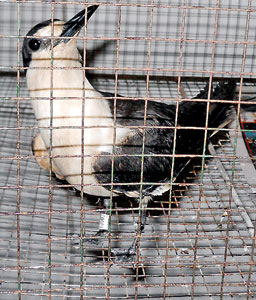“Birds are dying in many parts of Sri Lanka”, “Sri Lanka’s bird deaths likely to spread to Wildlife Parks”, “Could it be Bird Flu..?” these are headlines we have seen in recent weeks. The dead birds were reported from many parts of the island and the Department of Wildlife Conservation (DWC) put its regional offices on alert. A media alert too was issued, and many dead birds were reported to the DWC. They all belonged to a bird species called Sooty Terns.
“These dead birds were mainly reported between May 11 and 26. Some of the birds had been dead a few days at the time of the recovery while others were fresh carcasses. About 40 dead birds were found around the country,” a Department of Wildlife Conservation official said. The DWC had handed over samples of these bird carcasses to the Medical Research Institute (MRI) for testing, but the reports had not showed any sign of an illness that could have caused the deaths. However, ornithologists had an answer for the puzzle.
“The Sooty Tern is a pelagic seabird that flies across the oceans and comes to land only to breed. The strong winds occasionally bring them to the land,” said Prof. Sarath Kotagama, veteran ornithologist of the Field Ornithology Group of Sri Lanka (FOGSL) based at the University of Colombo. “The birds can die due to exhaustion trying to fly against the wind and it is not a rare phenomenon during this time of the year,” revealed Prof. Kotagama.
The veteran ornithologist also said these Sooty Terns are migratory and on their way back North after breeding. This migration happens between end of May and can go on until July, but evades our eyes unlike the other migrants, as these birds take a seabound route. Sooty Terns only pass through our country, so they are known as Passage Migrants.
Sea birds usually nest as large colonies and many tropical islands have been their breeding grounds for centuries. Most of the dead birds found in Sri Lanka are also said to be young birds that could have been making their first journey from their breeding grounds. But there were three special birds among the dead Sooty Terns- marked with a ring. Ornithologists ring birds to mark their presence in a location. The small metal or plastic ring around one of the bird’s legs contains basic information indicating the ringing location, so the information can be used to track the origin of the bird.
Quite amazingly, two of these ringed Sooty Terns were traced back to the African region. The Sooty Tern found in Battaramulla was wearing a ring placed in the African island of Madagascar from a ringing programme conducted by UK ornithologists and the other bird found in Chilaw was ringed in Seychelles by a group of French ornithologists. The third ring on a bird found in Jaffna has yet to be traced back, but the DWC is checking to find its origin.
Story of the recovered Sooty Tern
A small cage placed in a corner of the garden of Kithsiri Gunawardane in Borella held a Sooty Tern, which spread its wings in anticipation of the dinner which Kithsiri was bringing – some fresh halmassas (Sprats). The bird gulped the sprats and wanted more.
 |
| The Sooty Tern waits for Kithsiri
to bring its dinner |
“These sprats are soaked in salt water. Sooty Terns catch fish directly from the sea and gulp them whole. So together with their meal and drinks, they consume more salt and it is important to keep this salt balance while in captivity,” Kithsiri said. The Joint Secretary of the Ceylon Bird Club, he takes the bird out every evening and allows it to stretch its wings to give exercise to its shoulder muscles to get it ready for freedom again.
Though now fully recovered, the bird’s condition was pretty bad at the time it was found in a garden in Panadura on May 26. Manoja, daughter of the house owners had alerted Kithsiri who had rushed there.
The Sooty Tern was so exhausted that Kithsiri worried about its chances of recovery. The bird had to be initially hand-fed. Like many other birds in trouble, the Sooty Tern too had diarrhoea. Kithsiri had a little remedy for this and had given it a few drops of Cytexin – and added a little glucose to the bird’s diet to help it regain its strength.
His efforts to help the bird have succeeded and Kithsiri is now planning to release the bird in the next few days. The Sooty Tern is also tagged with a ring given by the DWC with “Info Sri Lanka – DWLC 001” on it- so if found in any parts of the world, it will be known that it was in Sri Lanka. |


